Title: “A Divine Odyssey: Unveiling the Top 10 Places to Visit in Ayodhya with Travel Tips”
Introduction:
Top sights in Ayodhya: Nestled on the banks of the sacred Sarayu River, Ayodhya beckons pilgrims and wanderers alike with its rich tapestry of history, spirituality, and cultural heritage. From revered temples to historical sites, Ayodhya offers a profound journey through time. Let’s embark on a divine odyssey as we explore the top 10 places to visit in Ayodhya, complete with travel insights on how to reach, delectable food options, and cozy hotel retreats.
List of Top 10 Places to Visit in Ayodhya:
1. Ram Mandir Ayodhya (Ram Janmabhoomi):
In the heartland of Ayodhya, where the whispers of ancient tales echo through the ages, stands a sacred ground that has been at the epicenter of cultural, religious, and historical conversations—Ram Janmabhoomi, the revered birthplace of Lord Rama. Reverberating with the collective hopes and dreams of millions, this hallowed site, now adorned by the grandeur of the Ram Mandir, is not just a physical structure but a symbol of a profound cultural renaissance, embodying the spirit of faith, resilience, and the enduring pursuit of shared heritage. Join us on a journey to explore the significance and transformation of Ram Janmabhoomi, where history, spirituality, and the aspirations of a nation converge in a narrative etched in stone and devotion.

How to Reach: Ayodhya has good road connectivity, and the nearest railway station is Faizabad Junction. The temple is easily accessible from major cities like Lucknow and Varanasi.
Hotels: Options range from budget accommodations to mid-range hotels; some popular choices include Shri Ram Ashram and Ramprastha.
Food: Explore local eateries for authentic North Indian cuisine.
2. Hanuman Garhi:
In the heart of Ayodhya, where legends intertwine with devotion, stands the venerable Hanuman Garhi. A sacred sanctuary perched on a hill, this ancient temple not only echoes with the divine tales of Lord Hanuman but also breathes life into the spiritual tapestry of this historic city. With each step leading to its hallowed grounds, one embarks on a journey through time, immersing in the mystical aura that makes Hanuman Garhi not just a temple but a living testament to faith and folklore.
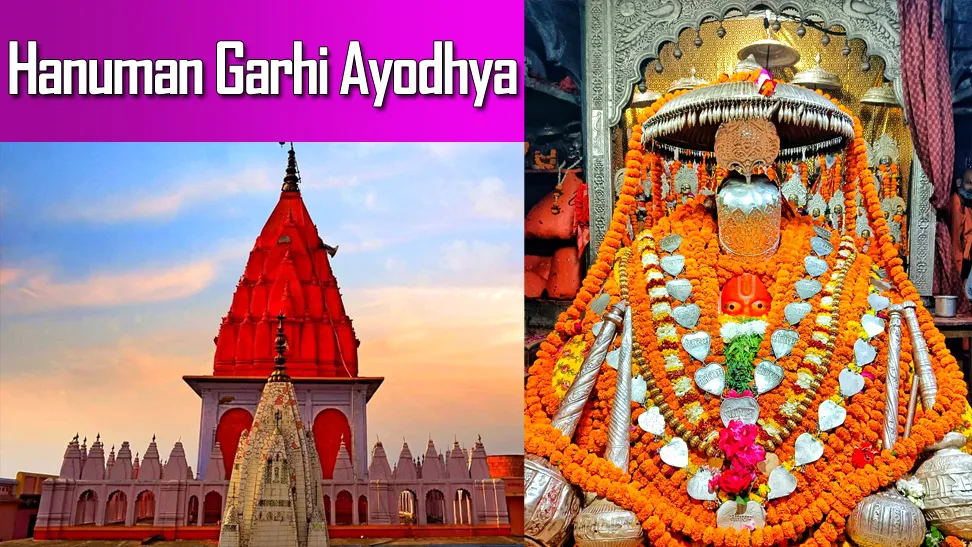
How to Reach: Located in the heart of Ayodhya, Hanuman Garhi is easily accessible by road. It’s a short drive from the main city center.
Food: Savor local snacks at nearby stalls, or head to restaurants in Ayodhya for a variety of vegetarian delights.
Hotels: Consider staying at Shri Ram Ashram or Hotel Torna Mansion for proximity to Hanuman Garhi.
3. Kanak Bhavan:
Nestled amidst the ancient cityscape of Ayodhya, Kanak Bhavan stands not only as an architectural marvel but as a timeless testament to devotion and historical resonance. This sacred abode, with its golden hues reflecting the radiance of mythological tales, invites pilgrims and enthusiasts alike to traverse the corridors of time and immerse themselves in the sanctity of a structure that echoes the whispers of centuries gone by. Kanak Bhavan, bathed in the glow of spirituality, unfolds a narrative that intertwines faith, folklore, and architectural splendor, beckoning visitors to embark on a journey that transcends the bounds of ordinary existence.
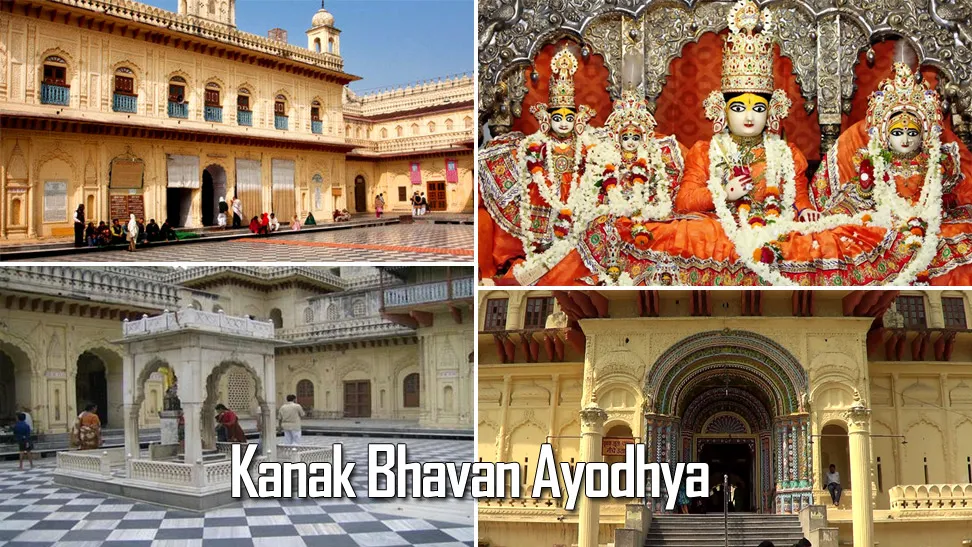
How to Reach: Situated near Hanuman Garhi, Kanak Bhavan is easily accessible on foot or by local transport.
Food: Ayodhya’s bustling markets offer a range of street food options. Don’t miss trying local sweets like peda.
Hotels: Opt for accommodations near the main city center, such as Hotel Deep Avadh or Hotel Gargee Grand.
4. Treta Ke Thakur:
In the mystical corridors of time, where ancient legends intertwine with the echoes of bygone eras, emerges a figure shrouded in the tapestry of myth and wisdom—Treta Ke Thakur. As if whispered through the ages, this enigmatic entity stands at the crossroads of history, a guardian of tales yet to unfold. Join us on a journey to unravel the mysteries and explore the essence of Treta Ke Thakur, a symbol of an era long past, yet forever imprinted on the fabric of our collective imagination.
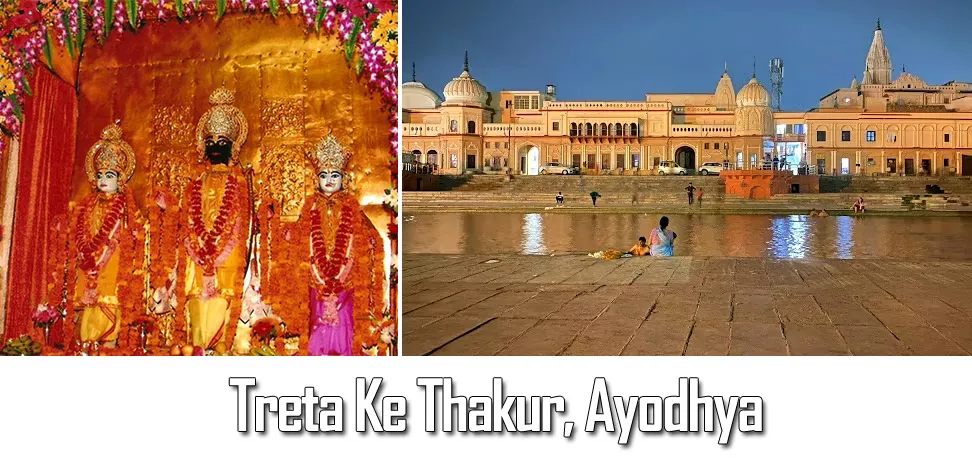
How to Reach: Located in the heart of Ayodhya, Treta Ke Thakur is easily reachable by rickshaw or on foot from the city center.
Food: Explore local eateries for snacks or indulge in traditional vegetarian thalis at nearby restaurants.
Hotels: Choose accommodations in Ayodhya’s central area, such as Hotel Anand and Hotel Shri Ram.
5. Swarg Dwar:
In the heartland of Uttar Pradesh, where ancient echoes blend seamlessly with the vibrant pulse of the present, lies a city veiled in myth and steeped in reverence – Ayodha. However, within Ayodha, there exists a celestial enclave that transcends the earthly realm – Swarg Dwar, a celestial gateway shrouded in the mystique of Hindu mythology. As the earthly city breathes with tales of Lord Rama and the epic Ramayana, Swarg Dwar stands as a testament to the divine allure, beckoning pilgrims and seekers into a realm where spirituality and legend intertwine. Join us on a journey where the earthly and the celestial converge, where the very air resonates with the divine, and Swarg Dwar Ayodha emerges as a portal to an ethereal tapestry of faith and wonder.
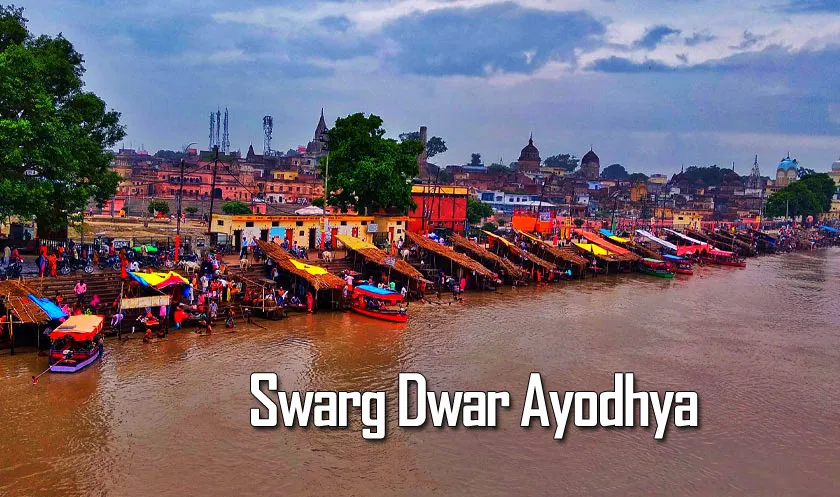
How to Reach: Swarg Dwar is centrally located, accessible by local transport, rickshaws, or a short walk from the main city area.
Food: Explore local eateries for street food or dine at nearby restaurants for North Indian specialties.
Hotels: Consider staying at Hotel Gargee Grand or Hotel Anand for proximity to Swarg Dwar.
6. Nageshwarnath Temple:
Nestled within the spiritual embrace of Ayodhya, the Nageshwarnath Temple stands as a silent sentinel, whispering tales of antiquity and devotion. Veiled in the mists of time, this sacred sanctuary unveils a tapestry woven with the threads of myth, history, and the undying faith of those who have sought solace within its hallowed precincts. As the gentle winds carry echoes of ancient chants and the temple bells resonate with the heartbeat of the city, the Nageshwarnath Temple beckons both pilgrims and curious souls alike to embark on a journey through the sanctified corridors of Ayodhya’s spiritual legacy.
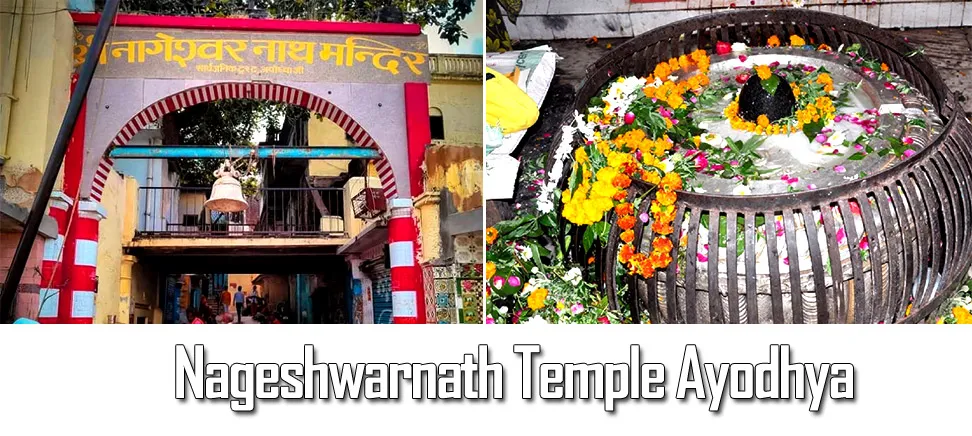
How to Reach: Located in the city center, Nageshwarnath Temple is easily accessible on foot or by local transport.
Food: Savor local vegetarian dishes at nearby eateries or explore the markets for street food.
Hotels: Choose accommodations near the city center, such as Hotel Gargee Grand or Hotel Anand.
7. Ramkot:
Nestled on the sacred soil of Ayodhya, Ramkot stands as an emblem of spiritual resonance and historical significance. This hallowed precinct, surrounded by the gentle whispers of the Sarayu River, resonates with the timeless tales of Lord Rama. As pilgrims and seekers alike traverse the winding lanes, they encounter a living tapestry of faith, where the echoes of ancient epics harmonize with the serene landscapes, creating an ethereal aura that beckons visitors to embark on a journey through the heart of Ayodhya’s spiritual legacy. Welcome to Ramkot, a sanctuary where myth and devotion intertwine, inviting all to witness the divine tales etched into the very fabric of this celestial city.
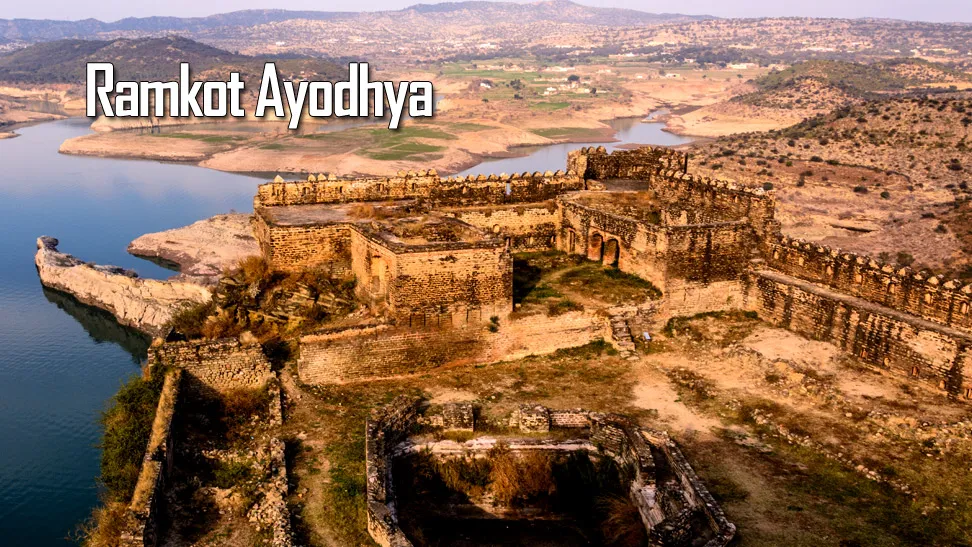
How to Reach: Ramkot is situated on the outskirts of Ayodhya. Hire a local taxi or use your own vehicle to reach this tranquil spot.
Food: Carry snacks or arrange for a packed meal. Explore local eateries upon returning to the city.
Hotels: Stay in the main city area at hotels like Hotel Shri Ram or Hotel Torna Mansion.
8. Choti Chhavani:
Nestled within the sacred embrace of Ayodhya, a city resonating with timeless echoes of mythology and spirituality, lies the enchanting haven known as Choti Chhavani. Beyond the bustling lanes and historic monuments, this hidden gem beckons visitors with its serenity and cultural allure, offering a retreat into the heart of Ayodhya’s mystique. As the sun casts its warm glow over Choti Chhavani, the air becomes infused with tales of ancient wisdom and the promise of an immersive journey through the spiritual tapestry of Ayodhya.
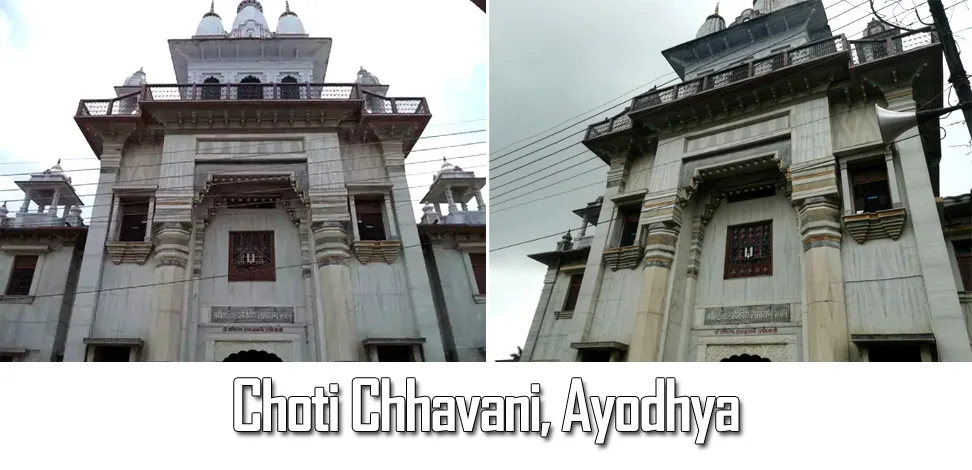
How to Reach: Located in the city center, Choti Chhavani is easily reachable on foot or by local transport.
Food: Indulge in local street food or dine at nearby restaurants for a taste of Ayodhya’s culinary delights.
Hotels: Opt for accommodations near the city center, such as Hotel Deep Avadh or Hotel Anand.
9. Gulab Bari:
Nestled within the heart of Ayodhya, the city resonating with ancient echoes and cultural richness, lies the enchanting Gulab Bari. Beyond its literal translation as the “Garden of Roses,” Gulab Bari is a tapestry of history and beauty that unfolds with every step, inviting visitors to immerse themselves in the fragrant blooms and the whispered tales of a bygone era. In the embrace of Gulab Bari’s timeless allure, Ayodhya reveals not just a garden, but a living testament to the city’s poetic past and the enduring spirit of its heritage.
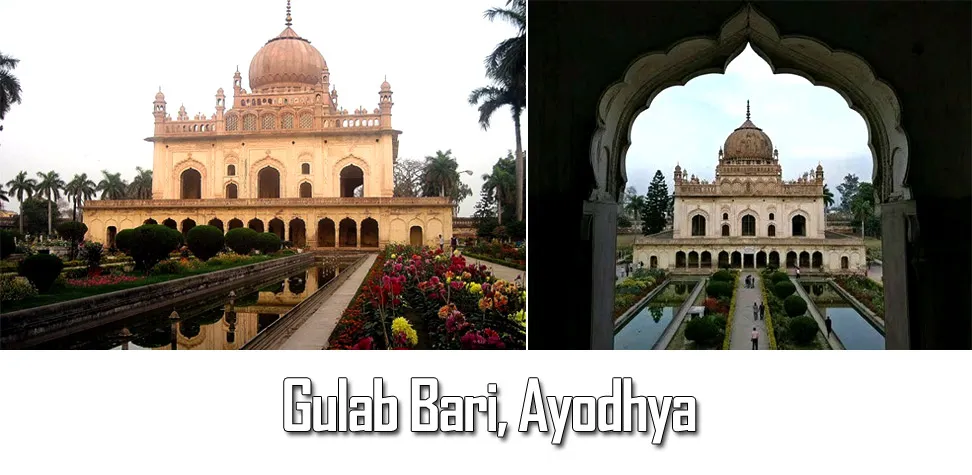
How to Reach: Situated in the heart of Ayodhya, Gulab Bari is easily accessible on foot or by rickshaw from the city center.
Food: Explore local eateries for snacks or dine at nearby restaurants serving North Indian cuisine.
Hotels: Stay centrally at hotels like Hotel Deep Avadh or Hotel Anand for proximity to Gulab Bari.
10. Birla Temple:
Nestled amidst the ancient cityscape of Ayodhya, where myth and history intertwine, stands the resplendent Birla Temple, a radiant testament to devotion and architectural magnificence. This celestial abode, poised on the banks of the serene Sarayu River, not only echoes the sacred hymns of the past but also encapsulates the timeless spirit of reverence and artistry in its divine structure. As the sun’s golden hues kiss its marble façade, the temple stands as a beacon, drawing pilgrims and enthusiasts alike into a realm where spirituality meets architectural grandeur.
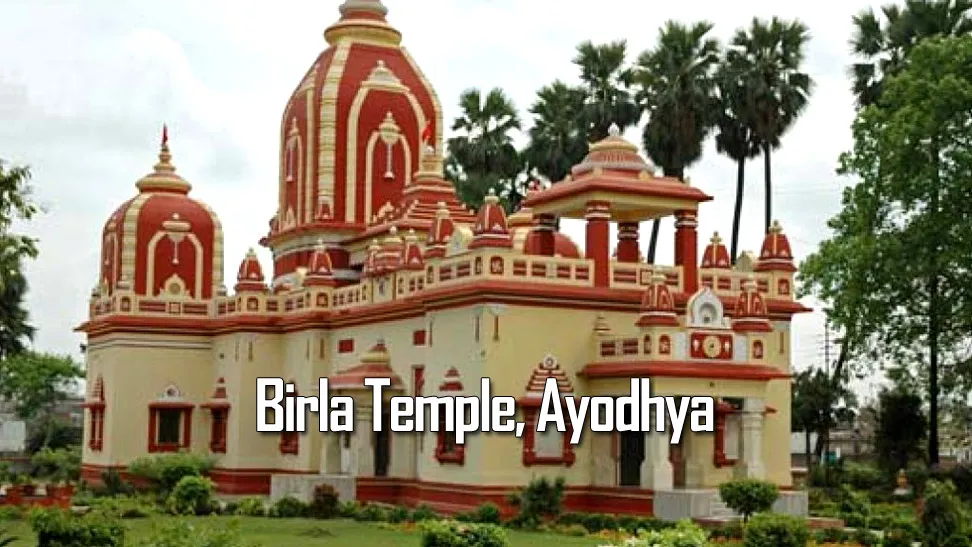
How to Reach: Birla Temple is located near the city center, easily reachable on foot or by local transport.
Food: Savor local street food or dine at nearby restaurants offering a variety of vegetarian options.
Hotels: Choose accommodations near the city center, such as Hotel Gargee Grand or Hotel Deep Avadh.
Conclusion:
Ayodhya, a city resonating with the echoes of ancient tales, offers a spiritual and cultural sojourn for every traveler. From the revered Ram Janmabhoomi to the tranquil Ramkot, each place holds a unique charm. Embrace the divine aura, relish local flavors, and find comfort in Ayodhya’s welcoming accommodations as you embark on a soul-stirring journey through this timeless city. In this article we covered the top sights in Ayodhya.
FAQ
What are the must-visit historical sites in Ayodhya?
Key historical sites include Ram Janmabhoomi, Hanuman Garhi, and Kanak Bhawan, all intricately tied to the rich mythology of Ayodhya.
Are there any serene spots for spiritual contemplation in Ayodhya?
Yes, the banks of the Sarayu River and the tranquil gardens surrounding Treta Ke Thakur are ideal places for spiritual reflection.
What is the significance of Ram Janmabhoomi in Ayodhya?
Ram Janmabhoomi is believed to be the birthplace of Lord Rama, a revered deity in Hinduism. It holds immense religious and historical importance.
How can one explore the cultural heritage of Ayodhya?
Explore the Ayodhya Museum to witness artifacts and exhibits that showcase the cultural heritage of the region.
What is the best time to visit Ayodhya?
The months of October to March are considered ideal due to pleasant weather, making it suitable for sightseeing and outdoor activities.
Are there any vibrant festivals celebrated in Ayodhya?
Diwali, the festival of lights, is celebrated with great enthusiasm in Ayodhya, attracting visitors from far and wide.
What is the architectural significance of Hanuman Garhi?
Hanuman Garhi is a Hanuman temple known for its unique architecture and panoramic views of Ayodhya, making it a significant religious site.
Are there any lesser-known places worth exploring in Ayodhya?
Choti Chhavani, Sita Ki Rasoi, and Guptar Ghat are lesser-known but culturally rich sites that offer a unique experience.
How can one reach Ayodhya?
Ayodhya is well-connected by road and rail. The nearest airport is in Lucknow, approximately 135 kilometers away.
What role does the Sarayu River play in Ayodhya’s cultural landscape?
The Sarayu River holds cultural and spiritual significance, with ghats along its banks providing peaceful spots for reflection and prayer.


Really helpful breakdown of Ayodhya’s highlights—Ram Mandir and Hanuman Garhi are obviously central, but I like that you also included quieter spots like Choti Chhavani and Gulab Bari. The travel tips on food and hotels make it more practical too. For anyone who enjoys this mix of spirituality and culture, Bhutan offers a similar kind of depth.